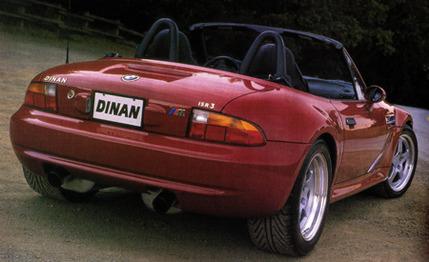
 Specialty File
Specialty File
You've probably noticed by now that the latest BMW M3 has arrived here with a more powerful engine that used to be exclusive to the European market. What you might not know is that the new engine will also power the 2001 M roadster and M coupe models. That pretty much renders your older M coupe or roadster obsolete, doesn't it?
Unless, that is, you ordered your car to be modified and supplied by Dinan as a factory-works vehicle -- a program Dinan runs in conjunction with BMW of North America through 76 authorized dealers to supply super-quick variants with fully supported warranties.
In the case of M roadsters and coupes, the breathed-on models are available in three stages of tune. S1 and S2 packages include suspension tweaks, engine software upgrades, and induction and exhaust modifications, along with a Dinan plaque and badging. The Stage 2 kit, predictably, goes further with the upgrades and adds big wheels.
But for the seriously horsepower-hungry owner (no need to raise your hand), there's the Dinan ISR 3. That's shorthand for intercooled, supercharged roadster, 3-series, which provides 396 horsepower at 6500 rpm and a stump-tugging 326 pound-feet of torque at 5500.
Sure, the Dodge Viper does even better than that, but this is a 13-foot-long street luge with a 3.2-liter engine. Having close to 400 horsepower in this car would feel almost indecent if it weren't so much fun. There will be only 50 of these ISR 3s produced, so consider yourself fortunate if you ever get to drive one. And consider yourself extremely well heeled if you buy one, because the premium for this little rocketship is $37,000. Yeah, that's on top of the $43,270 base price of an M roadster, ratcheting your out-of-pocket expenses to a whopping $80,270.
For that you get a belt-driven Vortech supercharger delivering 10 pounds of boost to the engine via an air-to-air intercooler that is fitted in the front of the engine bay, where it shares the wind blast produced by the radiator fan. The fan comes on automatically when the engine senses boost and stays on for three minutes to reduce heat soak.
Two differently sized compressor bypass valves are fitted, one ahead and one aft of the intercooler, to eliminate surging or stumbling. The engine also wears an oil cooler; large-diameter, high-flow throttle-body and airflow-meter assemblies; and a high-flow fuel-delivery system to provide sufficient fuel for the increased airflow. A polished and ported intake manifold with increased runner diameters conducts the high-pressure air to the cylinders, while a free-flow stainless-steel exhaust system eases the gas out to the accompaniment of a fine baritone sound.
Both the engine-control computer and the VANOS variable-valve-timing system were reprogrammed to match the engine's new power characteristics. To get all this newfound grunt to the road, Dinan fitted a lightweight clutch assembly that is nearly 15 pounds lighter than BMW's dual-mass unit yet has a 20-percent-greater clamping force. Then, because the car wears big 285/40ZR-17 tires on the rear axle, Dinan replaced the stock 3.23:1 rear end with a limited-slip 3.38:1 differential.
That took care of the motivating aspects of the ISR 3, in itself not an easy or quick exercise, but Steve Dinan soon found that the stock chassis would not handle the power increases safely without substantial revision. The Z3 family, you might remember, took the semi-trailing-arm rear suspension from earlier BMW models. Dinan found the rear end prone to rapid camber and toe-angle shifts during pitch and roll that produced spooky handling.
Chassis flex added its own weird inputs, so Dinan bolted in a strut-tower brace as well as a set of matched performance springs, specially valved Dinan/Koni shocks, anti-roll bars, and camber-control devices. The result is a car that pulled 0.91 g in our skidpad test (Dinan says he has seen 0.92 g) and drove with a surprising combination of comfort and precision.
The ISR 3 now feels secure and planted in bends, with limited sensitivity to throttle position. Body-motion control, it has to be said, is tight, but the car responds in a more linear fashion than its stock siblings, and even the big 255/40ZR-17 front tires haven't markedly increased the front end's sensitivity to pavement grooves.